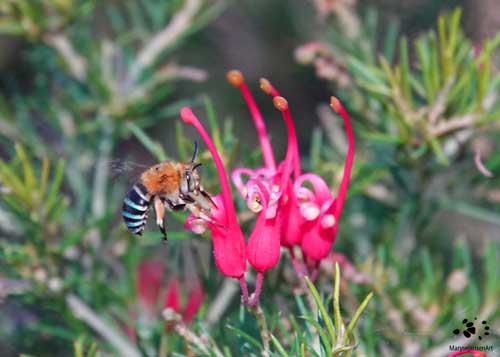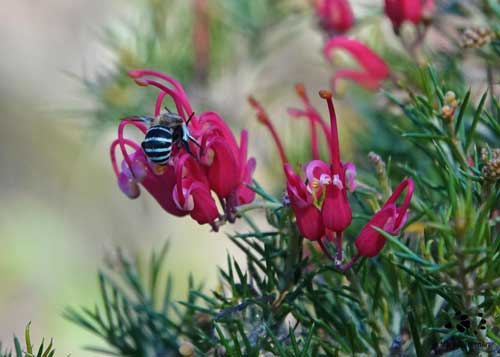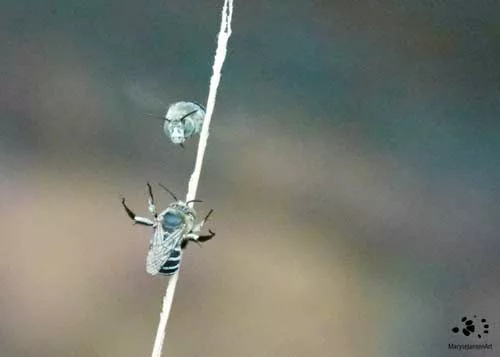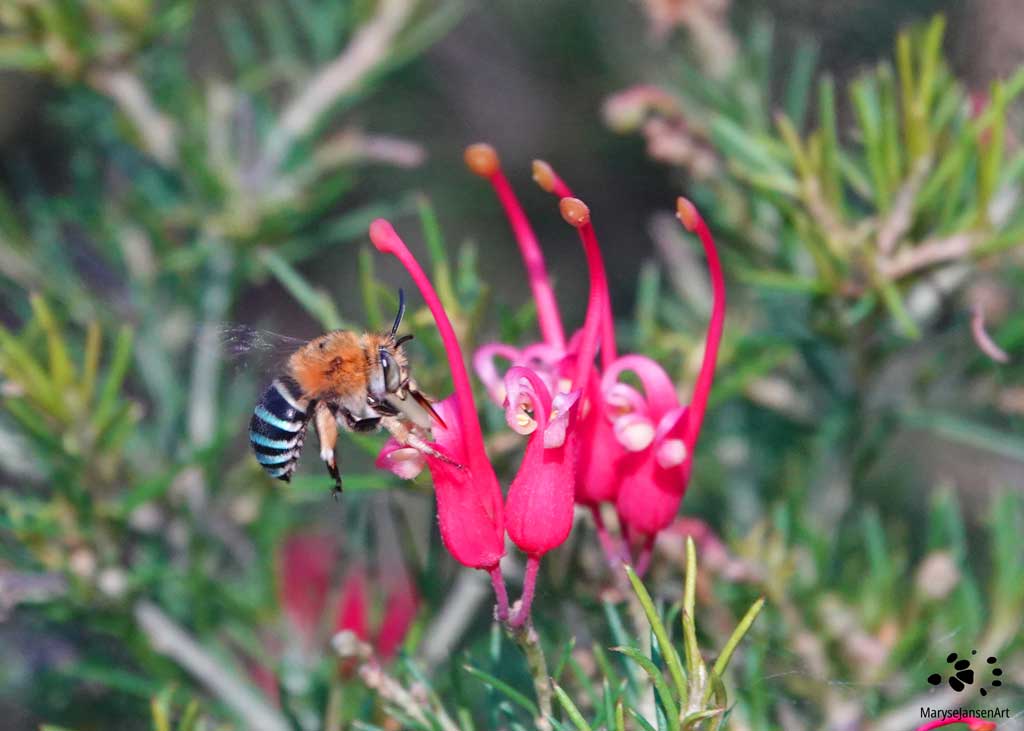Wildlife Photography with marysejansenart
Shining a light on pollinators during Australian Pollinator Week

Table of Contents
Spotting Blue-banded Bees in my backyard
Did you know that Australia has more then 1700 species of native bees? That’s an amazing number! It’ll take a true specialist to tell them all apart, but I am familiar with some of them. Among these, my favourites must be the Blue-banded Bees! They have been a common sight in my garden throughout the years. Their loud buzz and beautiful iridescent blue bands are sure to attract my attention. Sometimes I spot similar looking bees with green iridescent bands instead.
They’ve just started to appear again as I don’t see these bees during the winter. They live about 40 days. In the cold season the newest generation of immature bees rest inside their nests until the weather warms up. Then they develop into mature bees and fly out to visit the flowers in my garden. As this week (11-19 November 2023) is Australian Pollinator Week, it is a good opportunity to shine a light on these amazing little creatures!
There are actually 14 different species of Blue-banded Bees defined in Australia. And interestingly not all of these have blue-coloured bands! Some indeed have green bands, and others may have white or even orange bands! Usually the bands have iridescent properties. All these species belong to the genus Amegilla, so Banded Amegilla Bees has been suggested as a more accurate name. Blue-banded Bees may not always have blue bands, but they do always have green eyes! They have a furry head and thorax, in a red-brown colour. Their legs are also hairy. The bees are up to 1.4 cm long.
Burrowing a nest
Blue-banded bee females dig a nest burrow by themselves. They seek out sheltered spots, I often spot them disappearing in the spaces between the rocks. To dig a nest, a female bee moistens the soil and uses her jaws to dig it out. She carries the debris between her legs as she backs out of the 8mm narrow tunnel to clear it. A depth of 10cm is enough.
She lays each of her eggs in a separate cell, which she stocks with a liquid food supply of pollen and nectar. She seals the nest off with soil and moves on to a new nest location. It is possible that many females nest closely together in well suited spots.

Buzz Pollination
To fill all the nest cells with supplies, the female bees perform a lot of foraging. Blue-banded Bees are buzz pollinators. This means they use a special technique to release the pollen from the flowers of certain plants. They grab the flower and rapidly move their flight muscles and hit their head on it in such rapid succession that it is impossible to see with the naked eye!
This causes a vibration that dislodges the pollen into the air, where they can lift along on the hind legs of the bee or else be taken by the wind. You can hear it as a loud buzzing noise. The bee carries most of the pollen to her nest but as she hops from flower to flower she will leave some behind that serve to pollinate those flowers.
The skill of buzz pollination makes the Blue-banded Bees vitally important for the survival of a particular number of plants, which are not able to release their pollen in any other way. Examples of plants that require buzz pollination are Dianellas (Flax Lilies), Solanum (including native night shade species), Hibbertia (Guinea Flowers) and some Fabaceae (Pea Flowers). If you have your own veggie patch, this will interest you as this also applies to eggplants, tomatoes and potatoes, as well as blueberries and cranberries. Bear in mind though that each species of buzz pollinator will have their own preferences for certain plants.
Female vs Male Blue-banded Bees
As the sun is setting, I spot some Blue-banded Bees that are settling on the stalks of one of my Dianella plants. They are so cute to watch as they attach themselves to the stalks with their jaws and intermittently wriggle their bodies and legs like crazy, especially when another bee arrives that is looking for a spot.

When they finally settle, they curl their legs up under their bodies and go to sleep. These are the males, which roost in this way at night, while the females sleep in their burrows. Males and females can also be distinguished by the number of bands: males have five and females have four! Now that we know this, we can determine that the bee in the featured image is a male! Another way of telling the difference between male and female bees is that females carry the pollen on the special hairs on their hind legs, which is called a scopa. Males don’t have a scopa.
In the morning, when the roosting males have warmed up again, they fly out to forage and to find a female to mate with. The females appear as well and continue with their tasks. The flight of Blue-banded Bees is very fast and darting. They may hover for very short periods while feeding. Photographing them while they are foraging proves a formidable challenge! But I am pleased my efforts have paid of and I can share these beautiful images with you.
Finally, I’d like to invite you to watch this short video of the males getting ready for the night:
If you are interested in purchasing a print of the featured image ‘Blue-banded Bee on Red Spider Grevillea II‘ or would like to see what the image looks like on the various merchandise products, please head to my shop. If you prefer ‘Blue-banded Bee on Red Spider Grevillea I‘, click here.


